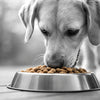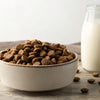Can I Mix Water with Dry Dog Food? Exploring the Benefits and Best Practices
- Houndsy
Table of Contents
- Introduction
- The Case for Adding Water to Dry Dog Food
- Potential Downsides of Adding Water to Dry Dog Food
- Tips for Adding Water to Dry Dog Food
- Conclusion
Introduction
As dog owners, we strive to provide the best for our furry companions, ensuring they receive the right nutrition and hydration. Did you know that over 60% of dog owners have considered altering their dog's diet to enhance its health and well-being? One common question that arises is: Can I mix water with dry dog food? This article delves into the pros and cons of adding water to kibble, helping you make an informed decision that suits your dog's needs.
By the end of this comprehensive guide, you will understand how moistening dry food can improve hydration, enhance palatability, and aid digestion. We'll also discuss potential downsides, tips for properly mixing water into kibble, and considerations for specific health conditions. So, grab a cup of water and let’s dive into how we can elevate our dogs' feeding experience together!
The Case for Adding Water to Dry Dog Food
Enhanced Palatability
One of the most compelling reasons to add water to dry dog food is to enhance its flavor and aroma. Dogs are instinctively attracted to moisture, which often signals freshness. By introducing water to kibble, we can unlock its potential, making it more appealing—especially for picky eaters or dogs recovering from illness.
Example: If your dog previously turned their nose up at dry kibble, a splash of warm water could transform that meal into a savory treat, enticing them back to their bowl.
Improved Hydration
Ensuring our pets stay hydrated is crucial for their health. Many dogs do not drink enough water daily. Mixing water with kibble can help bridge that gap, providing an additional source of hydration. This is particularly beneficial for older dogs or those living in warmer climates.
Statistics: Studies show that dogs consuming dry food alone may not meet their hydration needs, leading to potential health issues like urinary tract infections or kidney stones. By adding water, we support their overall well-being.
Easier Digestion
Adding water to kibble can facilitate digestion by softening the food, making it easier for dogs to chew and swallow. This is especially important for senior dogs or those with dental issues who may struggle with hard kibble.
Hypothetical Scenario: Imagine a senior dog who has difficulty chewing hard kibble. By soaking the kibble in water, we can create a gentler meal that is easier on their digestive system.
Dental Health Considerations
While some may argue that dry kibble helps clean teeth, the reality is more nuanced. Moistening kibble can be a safer option for dogs with dental issues, allowing them to enjoy meals without discomfort. However, it's crucial to maintain dental health through regular brushing and veterinary check-ups.
Weight Management
For dogs prone to overeating, adding water can increase the volume of their meals without significantly raising calorie intake. This can help them feel fuller and prevent rapid consumption.
Example: A Labrador who tends to gulp down food might benefit from moistened kibble, slowing down their eating and promoting better digestion.
Potential Downsides of Adding Water to Dry Dog Food
Risk of Spoilage
One of the main concerns with adding water to kibble is the risk of spoilage. Wet food can quickly become a breeding ground for bacteria, especially in warm conditions. It's crucial to serve the hydrated kibble immediately and discard any leftovers after a short period.
Loss of Crunch
While softening kibble can benefit some dogs, it also diminishes the crunchy texture that many dogs enjoy. This can affect their overall experience and satisfaction at mealtime.
Nutrient Loss
Extended soaking in water can lead to a loss of certain water-soluble vitamins and nutrients. It's essential to balance the benefits of hydration and palatability with the potential for nutrient degradation.
Changes in Feeding Routine
Switching to moistened kibble may alter your dog's feeding routine. Some dogs may take longer to eat, while others may not adapt well to the changed texture. Observing your dog’s reaction and adjusting accordingly is key.
Tips for Adding Water to Dry Dog Food
Start Slowly
If you’re new to adding water, begin with a small amount. A general guideline is to mix half a cup of warm water with a cup of kibble. This will help you gauge your dog's preference and tolerance without overwhelming them.
Use Warm Water
Warm water can help soften the kibble more effectively and enhance the aroma, making the meal even more enticing. Ensure the water is warm but not hot to avoid burning your dog’s mouth.
Serve Immediately
To minimize the risk of spoilage, serve the moistened kibble right away. If your dog doesn’t finish the meal, discard any leftovers after 60 minutes to prevent bacterial growth.
Experiment with Ratios
Every dog is unique, so experiment with different water-to-kibble ratios to find what your dog enjoys. You might find that they prefer slightly moistened kibble as opposed to fully soaked.
Monitor Your Dog's Response
Keep an eye on your dog’s digestion and overall health after introducing moistened kibble. If you notice any adverse reactions or changes in appetite, consult your veterinarian.
Conclusion
Ultimately, the decision to add water to dry dog food depends on your dog’s specific needs and preferences. By weighing the pros and cons, we can make informed choices that enhance our pets' health and happiness. Remember, hydration is vital for our canine companions, and adding water to kibble can be a simple yet effective way to support their well-being.
For those seeking to elevate their dog feeding experience further, consider exploring the Houndsy Kibble Dispenser. This innovative product simplifies portion control, enhances convenience, and complements modern home decor, making it the perfect addition to your pet care routine. Order Now and transform mealtime for your furry friend!
FAQ
Can I add cold water to dry dog food?
While cold water can be used, warm water is generally more effective for softening kibble and enhancing flavor.
How often should I add water to my dog's kibble?
You can add water daily, but it’s essential to monitor your dog’s response and adjust based on their preferences and health needs.
What if my dog refuses to eat moistened kibble?
If your dog is hesitant to eat moistened kibble, try reducing the amount of water or gradually increasing it over time. You can also consult your veterinarian for additional suggestions.
Are there specific types of kibble that are better for soaking?
Some kibble brands may be more suitable for soaking than others. Consult your vet or pet nutritionist to find the best options for your dog's dietary needs.
Should I mix wet and dry food?
Mixing wet and dry food can be beneficial, as it adds moisture and variety to your dog's diet. However, consult your veterinarian to ensure it aligns with your dog’s health needs.












